Biology Essay: Stem Cell Technology, Research and Life Implications
VerifiedAdded on 2023/06/08
|6
|1176
|401
Essay
AI Summary
This essay delves into stem cell technology, highlighting its potential in regenerative medicine and drug development. It discusses the use of stem cells in treating diseases like Parkinson's and spinal cord injuries, as well as their role in regenerating organs and testing anti-cancer drugs. The essay also addresses the limitations of stem cell technology, including autoimmune responses and ethical concerns related to embryo destruction. It emphasizes the importance of further research to overcome these challenges and fully realize the benefits of stem cell technology in treating various life-threatening conditions. Desklib offers a wealth of resources, including past papers and solved assignments, to aid students in their studies.
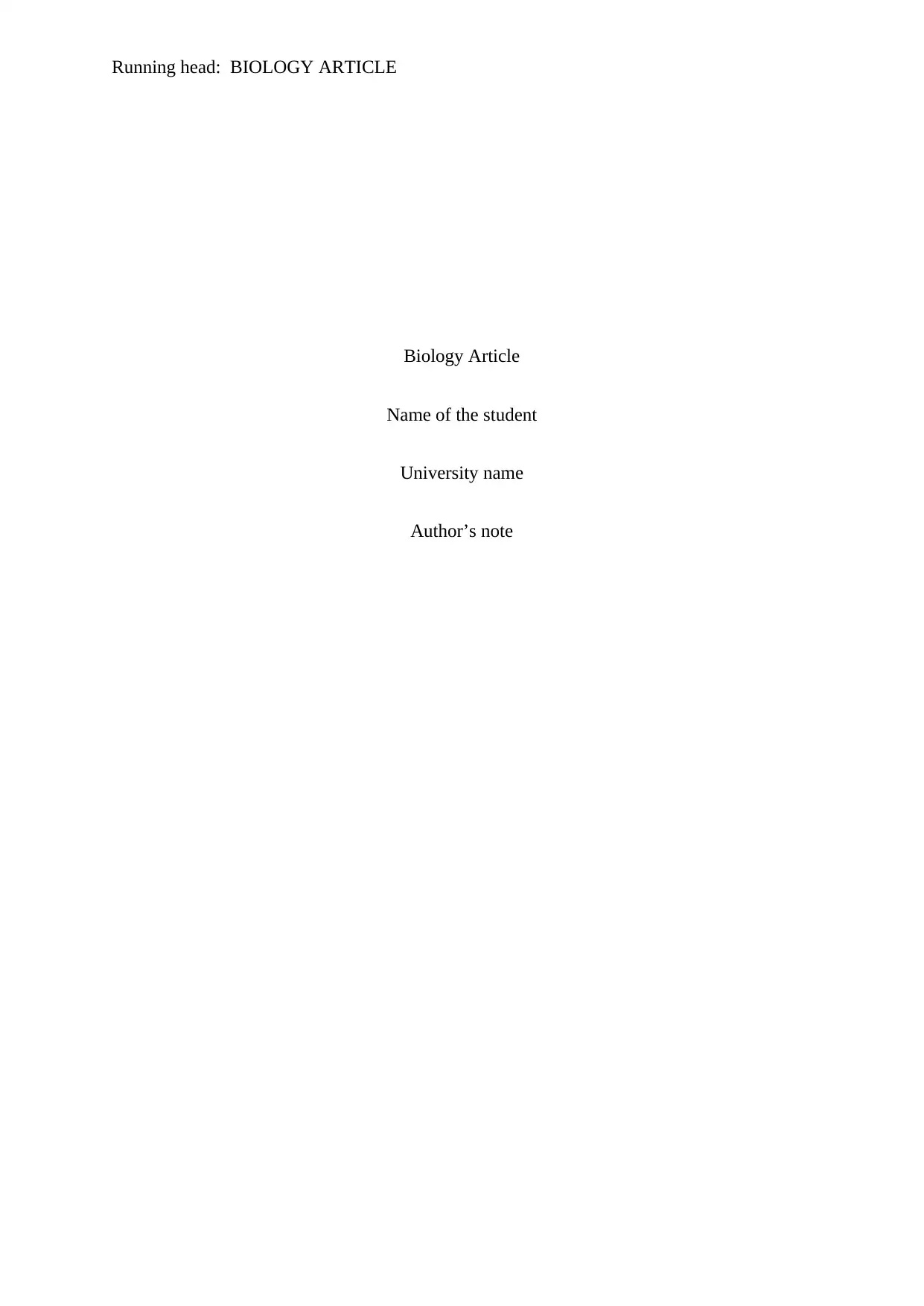
Running head: BIOLOGY ARTICLE
Biology Article
Name of the student
University name
Author’s note
Biology Article
Name of the student
University name
Author’s note
Paraphrase This Document
Need a fresh take? Get an instant paraphrase of this document with our AI Paraphraser
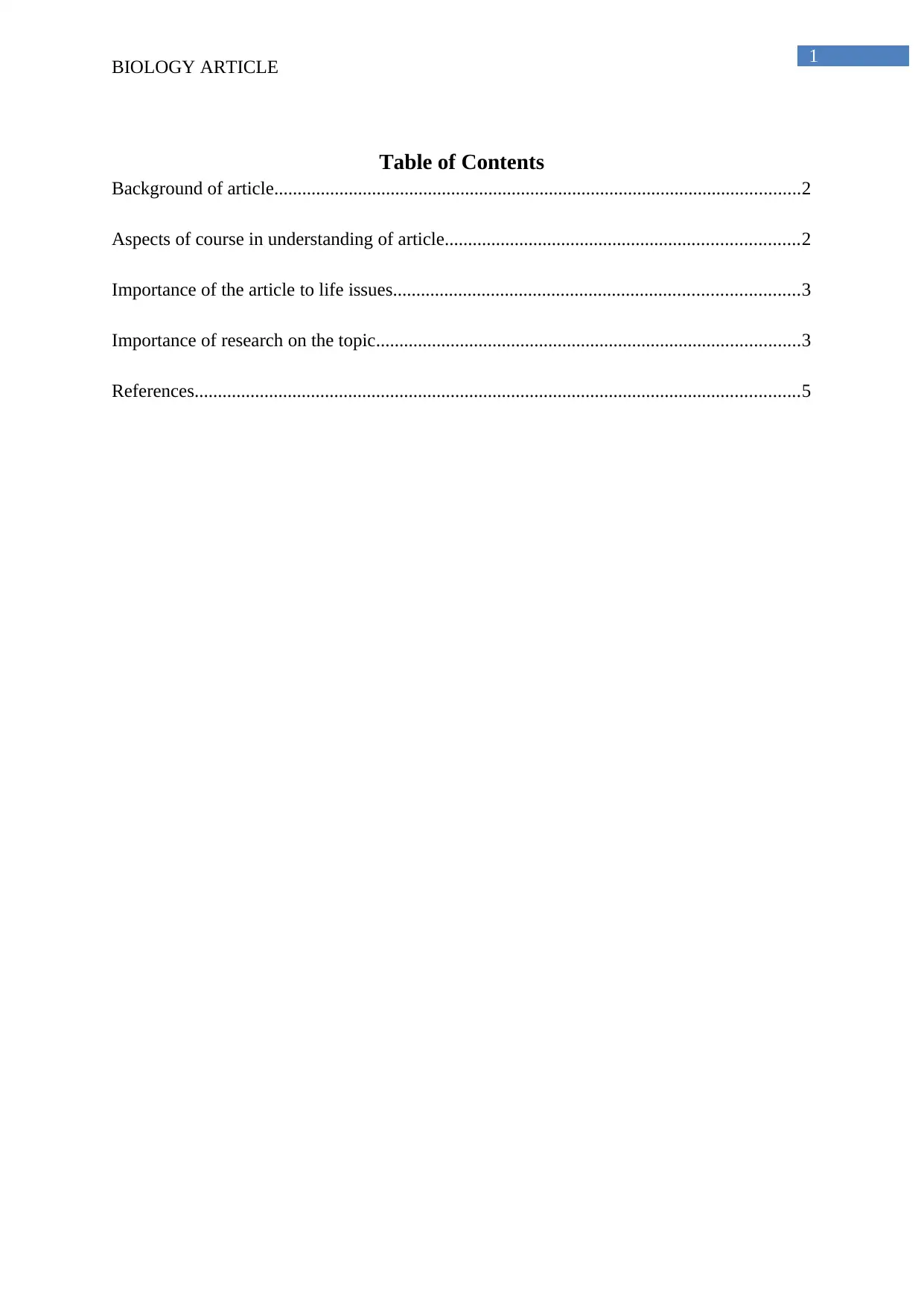
1
BIOLOGY ARTICLE
Table of Contents
Background of article.................................................................................................................2
Aspects of course in understanding of article............................................................................2
Importance of the article to life issues.......................................................................................3
Importance of research on the topic...........................................................................................3
References..................................................................................................................................5
BIOLOGY ARTICLE
Table of Contents
Background of article.................................................................................................................2
Aspects of course in understanding of article............................................................................2
Importance of the article to life issues.......................................................................................3
Importance of research on the topic...........................................................................................3
References..................................................................................................................................5
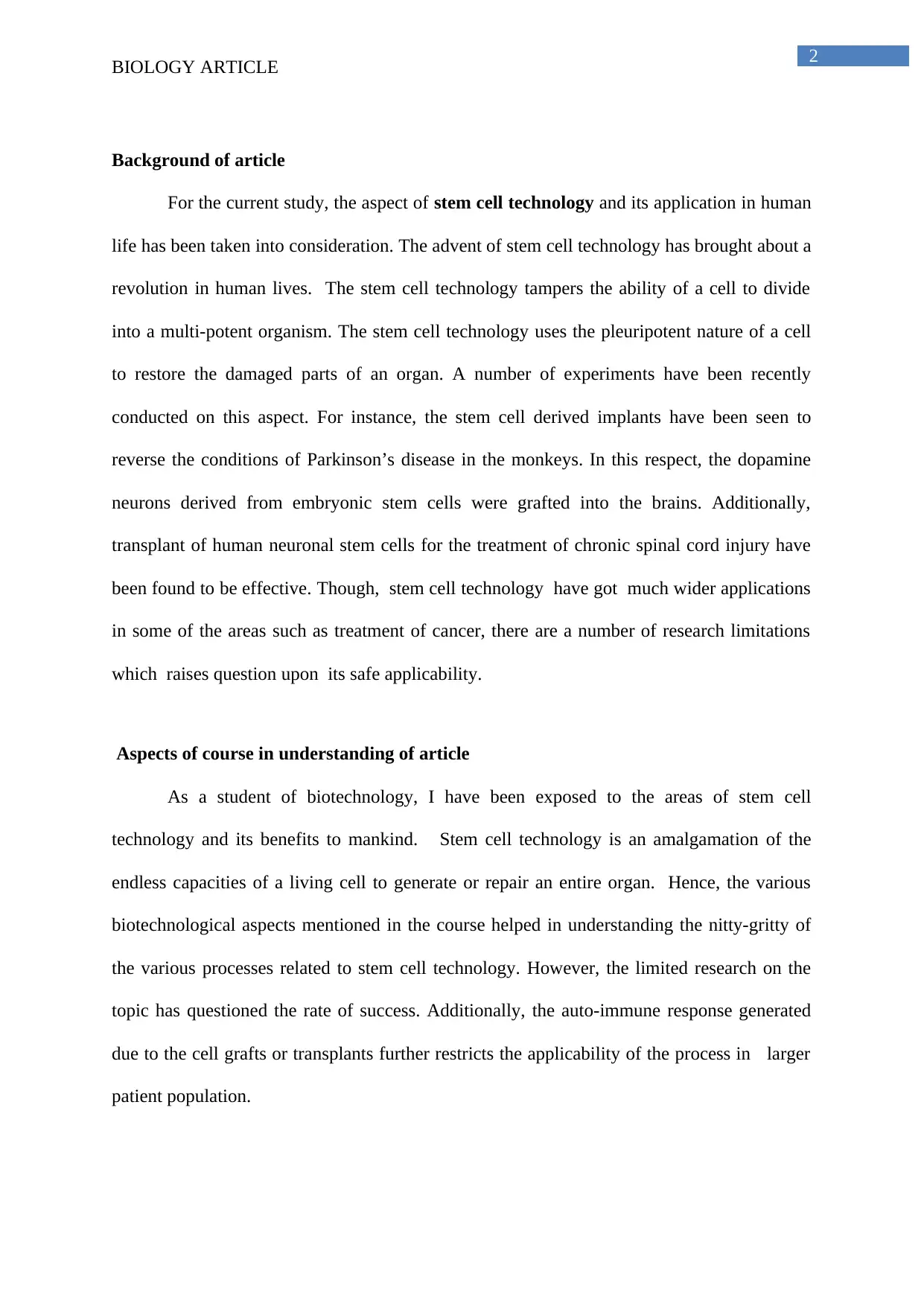
2
BIOLOGY ARTICLE
Background of article
For the current study, the aspect of stem cell technology and its application in human
life has been taken into consideration. The advent of stem cell technology has brought about a
revolution in human lives. The stem cell technology tampers the ability of a cell to divide
into a multi-potent organism. The stem cell technology uses the pleuripotent nature of a cell
to restore the damaged parts of an organ. A number of experiments have been recently
conducted on this aspect. For instance, the stem cell derived implants have been seen to
reverse the conditions of Parkinson’s disease in the monkeys. In this respect, the dopamine
neurons derived from embryonic stem cells were grafted into the brains. Additionally,
transplant of human neuronal stem cells for the treatment of chronic spinal cord injury have
been found to be effective. Though, stem cell technology have got much wider applications
in some of the areas such as treatment of cancer, there are a number of research limitations
which raises question upon its safe applicability.
Aspects of course in understanding of article
As a student of biotechnology, I have been exposed to the areas of stem cell
technology and its benefits to mankind. Stem cell technology is an amalgamation of the
endless capacities of a living cell to generate or repair an entire organ. Hence, the various
biotechnological aspects mentioned in the course helped in understanding the nitty-gritty of
the various processes related to stem cell technology. However, the limited research on the
topic has questioned the rate of success. Additionally, the auto-immune response generated
due to the cell grafts or transplants further restricts the applicability of the process in larger
patient population.
BIOLOGY ARTICLE
Background of article
For the current study, the aspect of stem cell technology and its application in human
life has been taken into consideration. The advent of stem cell technology has brought about a
revolution in human lives. The stem cell technology tampers the ability of a cell to divide
into a multi-potent organism. The stem cell technology uses the pleuripotent nature of a cell
to restore the damaged parts of an organ. A number of experiments have been recently
conducted on this aspect. For instance, the stem cell derived implants have been seen to
reverse the conditions of Parkinson’s disease in the monkeys. In this respect, the dopamine
neurons derived from embryonic stem cells were grafted into the brains. Additionally,
transplant of human neuronal stem cells for the treatment of chronic spinal cord injury have
been found to be effective. Though, stem cell technology have got much wider applications
in some of the areas such as treatment of cancer, there are a number of research limitations
which raises question upon its safe applicability.
Aspects of course in understanding of article
As a student of biotechnology, I have been exposed to the areas of stem cell
technology and its benefits to mankind. Stem cell technology is an amalgamation of the
endless capacities of a living cell to generate or repair an entire organ. Hence, the various
biotechnological aspects mentioned in the course helped in understanding the nitty-gritty of
the various processes related to stem cell technology. However, the limited research on the
topic has questioned the rate of success. Additionally, the auto-immune response generated
due to the cell grafts or transplants further restricts the applicability of the process in larger
patient population.
⊘ This is a preview!⊘
Do you want full access?
Subscribe today to unlock all pages.

Trusted by 1+ million students worldwide
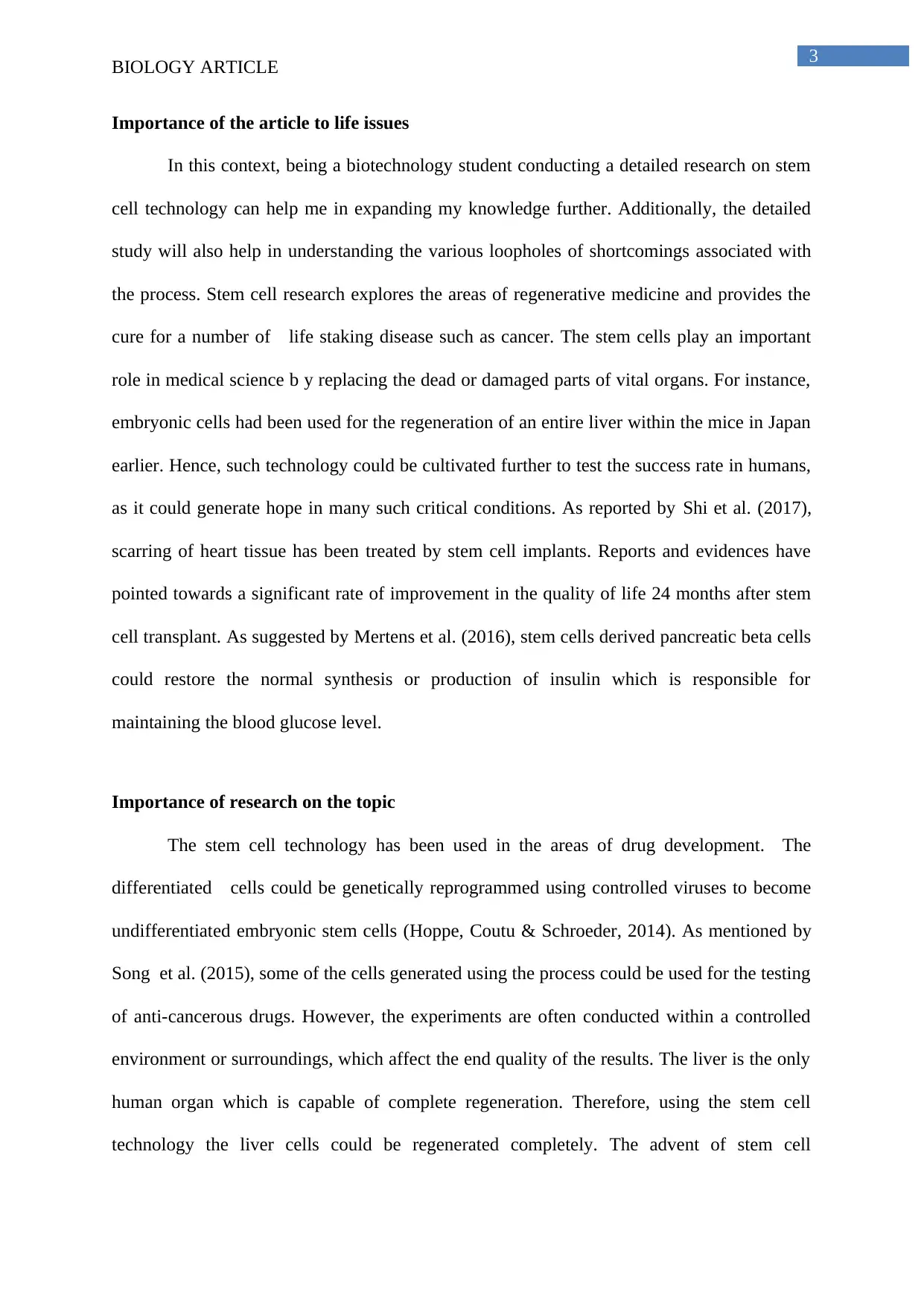
3
BIOLOGY ARTICLE
Importance of the article to life issues
In this context, being a biotechnology student conducting a detailed research on stem
cell technology can help me in expanding my knowledge further. Additionally, the detailed
study will also help in understanding the various loopholes of shortcomings associated with
the process. Stem cell research explores the areas of regenerative medicine and provides the
cure for a number of life staking disease such as cancer. The stem cells play an important
role in medical science b y replacing the dead or damaged parts of vital organs. For instance,
embryonic cells had been used for the regeneration of an entire liver within the mice in Japan
earlier. Hence, such technology could be cultivated further to test the success rate in humans,
as it could generate hope in many such critical conditions. As reported by Shi et al. (2017),
scarring of heart tissue has been treated by stem cell implants. Reports and evidences have
pointed towards a significant rate of improvement in the quality of life 24 months after stem
cell transplant. As suggested by Mertens et al. (2016), stem cells derived pancreatic beta cells
could restore the normal synthesis or production of insulin which is responsible for
maintaining the blood glucose level.
Importance of research on the topic
The stem cell technology has been used in the areas of drug development. The
differentiated cells could be genetically reprogrammed using controlled viruses to become
undifferentiated embryonic stem cells (Hoppe, Coutu & Schroeder, 2014). As mentioned by
Song et al. (2015), some of the cells generated using the process could be used for the testing
of anti-cancerous drugs. However, the experiments are often conducted within a controlled
environment or surroundings, which affect the end quality of the results. The liver is the only
human organ which is capable of complete regeneration. Therefore, using the stem cell
technology the liver cells could be regenerated completely. The advent of stem cell
BIOLOGY ARTICLE
Importance of the article to life issues
In this context, being a biotechnology student conducting a detailed research on stem
cell technology can help me in expanding my knowledge further. Additionally, the detailed
study will also help in understanding the various loopholes of shortcomings associated with
the process. Stem cell research explores the areas of regenerative medicine and provides the
cure for a number of life staking disease such as cancer. The stem cells play an important
role in medical science b y replacing the dead or damaged parts of vital organs. For instance,
embryonic cells had been used for the regeneration of an entire liver within the mice in Japan
earlier. Hence, such technology could be cultivated further to test the success rate in humans,
as it could generate hope in many such critical conditions. As reported by Shi et al. (2017),
scarring of heart tissue has been treated by stem cell implants. Reports and evidences have
pointed towards a significant rate of improvement in the quality of life 24 months after stem
cell transplant. As suggested by Mertens et al. (2016), stem cells derived pancreatic beta cells
could restore the normal synthesis or production of insulin which is responsible for
maintaining the blood glucose level.
Importance of research on the topic
The stem cell technology has been used in the areas of drug development. The
differentiated cells could be genetically reprogrammed using controlled viruses to become
undifferentiated embryonic stem cells (Hoppe, Coutu & Schroeder, 2014). As mentioned by
Song et al. (2015), some of the cells generated using the process could be used for the testing
of anti-cancerous drugs. However, the experiments are often conducted within a controlled
environment or surroundings, which affect the end quality of the results. The liver is the only
human organ which is capable of complete regeneration. Therefore, using the stem cell
technology the liver cells could be regenerated completely. The advent of stem cell
Paraphrase This Document
Need a fresh take? Get an instant paraphrase of this document with our AI Paraphraser
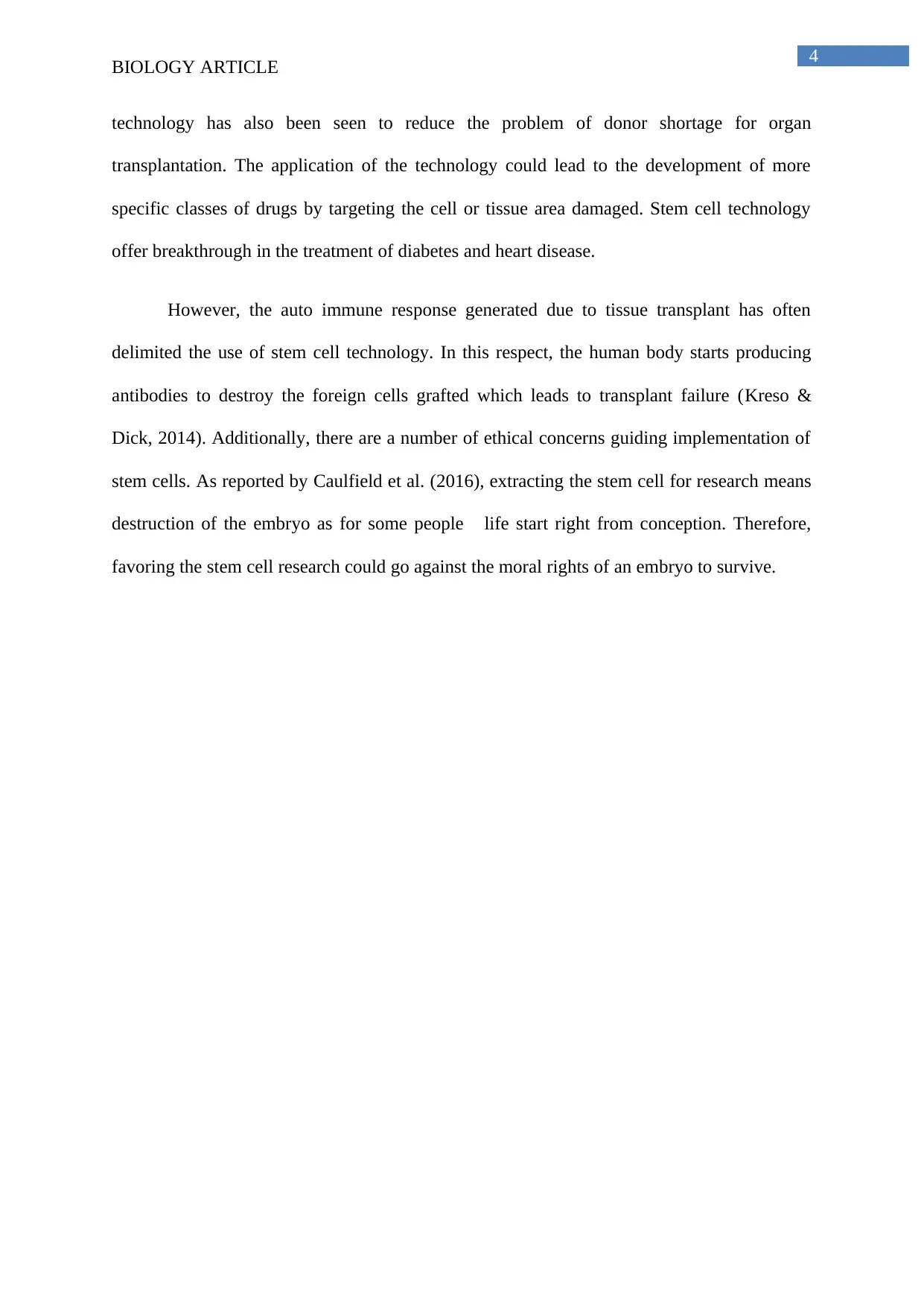
4
BIOLOGY ARTICLE
technology has also been seen to reduce the problem of donor shortage for organ
transplantation. The application of the technology could lead to the development of more
specific classes of drugs by targeting the cell or tissue area damaged. Stem cell technology
offer breakthrough in the treatment of diabetes and heart disease.
However, the auto immune response generated due to tissue transplant has often
delimited the use of stem cell technology. In this respect, the human body starts producing
antibodies to destroy the foreign cells grafted which leads to transplant failure (Kreso &
Dick, 2014). Additionally, there are a number of ethical concerns guiding implementation of
stem cells. As reported by Caulfield et al. (2016), extracting the stem cell for research means
destruction of the embryo as for some people life start right from conception. Therefore,
favoring the stem cell research could go against the moral rights of an embryo to survive.
BIOLOGY ARTICLE
technology has also been seen to reduce the problem of donor shortage for organ
transplantation. The application of the technology could lead to the development of more
specific classes of drugs by targeting the cell or tissue area damaged. Stem cell technology
offer breakthrough in the treatment of diabetes and heart disease.
However, the auto immune response generated due to tissue transplant has often
delimited the use of stem cell technology. In this respect, the human body starts producing
antibodies to destroy the foreign cells grafted which leads to transplant failure (Kreso &
Dick, 2014). Additionally, there are a number of ethical concerns guiding implementation of
stem cells. As reported by Caulfield et al. (2016), extracting the stem cell for research means
destruction of the embryo as for some people life start right from conception. Therefore,
favoring the stem cell research could go against the moral rights of an embryo to survive.
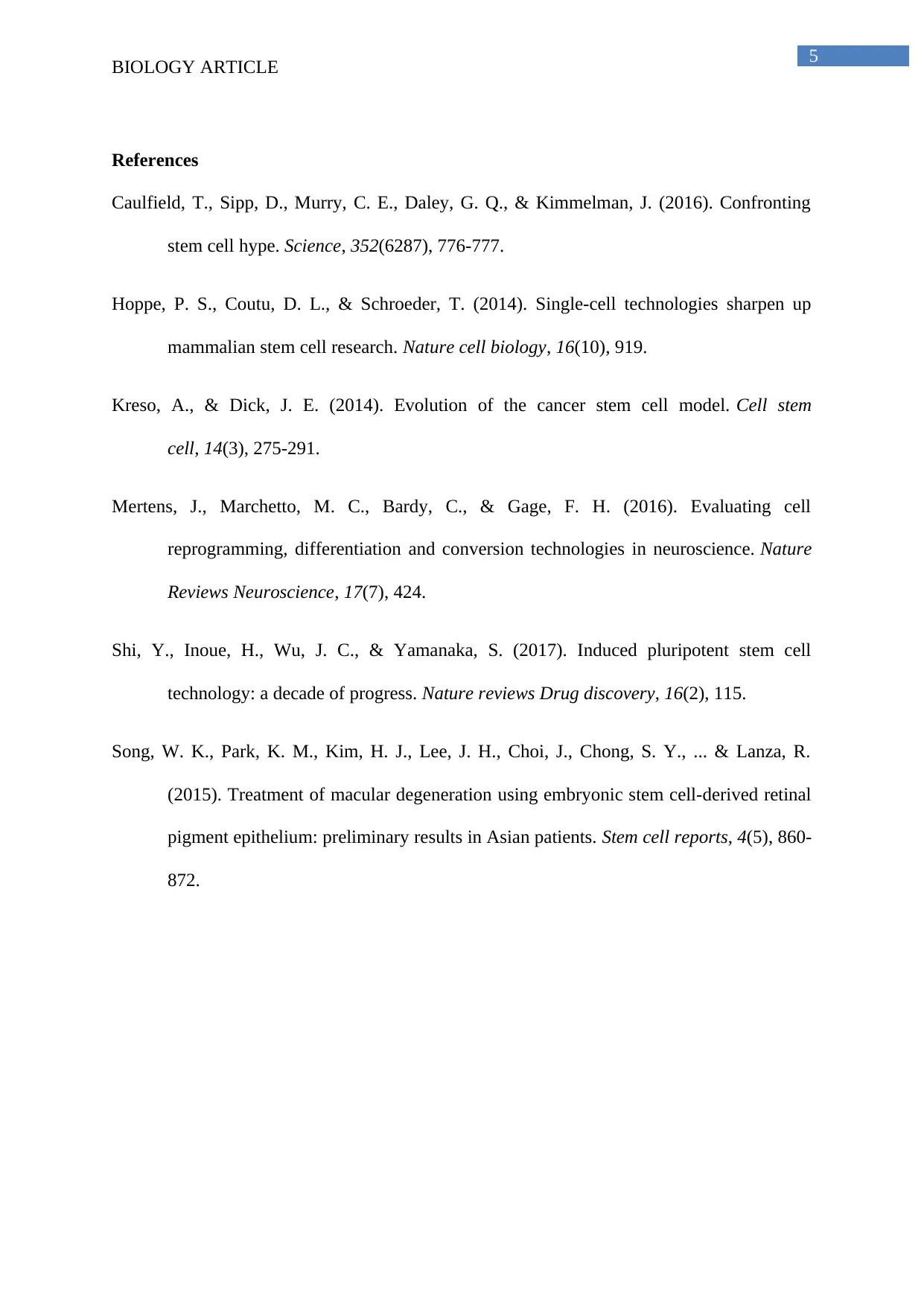
5
BIOLOGY ARTICLE
References
Caulfield, T., Sipp, D., Murry, C. E., Daley, G. Q., & Kimmelman, J. (2016). Confronting
stem cell hype. Science, 352(6287), 776-777.
Hoppe, P. S., Coutu, D. L., & Schroeder, T. (2014). Single-cell technologies sharpen up
mammalian stem cell research. Nature cell biology, 16(10), 919.
Kreso, A., & Dick, J. E. (2014). Evolution of the cancer stem cell model. Cell stem
cell, 14(3), 275-291.
Mertens, J., Marchetto, M. C., Bardy, C., & Gage, F. H. (2016). Evaluating cell
reprogramming, differentiation and conversion technologies in neuroscience. Nature
Reviews Neuroscience, 17(7), 424.
Shi, Y., Inoue, H., Wu, J. C., & Yamanaka, S. (2017). Induced pluripotent stem cell
technology: a decade of progress. Nature reviews Drug discovery, 16(2), 115.
Song, W. K., Park, K. M., Kim, H. J., Lee, J. H., Choi, J., Chong, S. Y., ... & Lanza, R.
(2015). Treatment of macular degeneration using embryonic stem cell-derived retinal
pigment epithelium: preliminary results in Asian patients. Stem cell reports, 4(5), 860-
872.
BIOLOGY ARTICLE
References
Caulfield, T., Sipp, D., Murry, C. E., Daley, G. Q., & Kimmelman, J. (2016). Confronting
stem cell hype. Science, 352(6287), 776-777.
Hoppe, P. S., Coutu, D. L., & Schroeder, T. (2014). Single-cell technologies sharpen up
mammalian stem cell research. Nature cell biology, 16(10), 919.
Kreso, A., & Dick, J. E. (2014). Evolution of the cancer stem cell model. Cell stem
cell, 14(3), 275-291.
Mertens, J., Marchetto, M. C., Bardy, C., & Gage, F. H. (2016). Evaluating cell
reprogramming, differentiation and conversion technologies in neuroscience. Nature
Reviews Neuroscience, 17(7), 424.
Shi, Y., Inoue, H., Wu, J. C., & Yamanaka, S. (2017). Induced pluripotent stem cell
technology: a decade of progress. Nature reviews Drug discovery, 16(2), 115.
Song, W. K., Park, K. M., Kim, H. J., Lee, J. H., Choi, J., Chong, S. Y., ... & Lanza, R.
(2015). Treatment of macular degeneration using embryonic stem cell-derived retinal
pigment epithelium: preliminary results in Asian patients. Stem cell reports, 4(5), 860-
872.
⊘ This is a preview!⊘
Do you want full access?
Subscribe today to unlock all pages.

Trusted by 1+ million students worldwide
1 out of 6
Related Documents
Your All-in-One AI-Powered Toolkit for Academic Success.
+13062052269
info@desklib.com
Available 24*7 on WhatsApp / Email
![[object Object]](/_next/static/media/star-bottom.7253800d.svg)
Unlock your academic potential
Copyright © 2020–2025 A2Z Services. All Rights Reserved. Developed and managed by ZUCOL.





